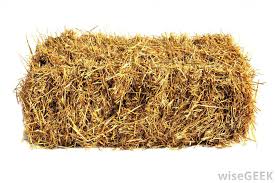The Question:
How long after hay is cut and baled should you wait before using it for feed to a horse?
Answer:
Any hay that has been properly cured and dried before being baled should be stable and can be fed as soon as needed. There are no nutritional advantages to storing hay for weeks or months prior to use. Hay actually looses some of its nutritional value when stored for long periods of time. If a nutrient analysis is to be done on the hay, it is suggested to wait about 17 days after baled before the samples are taken. Depending on the moisture content of the hay, it may “sweat” and a more accurate analysis can be obtained after this 17-day period. It is more important to be assured the hay was “put up” correctly. One of the most critical factors of field-cured hay--hay that is left out in the field to dry after is has been cut--are weather conditions that may influence the hay quality. Rain and excessive sunlight reduce the quality of hay by reducing the nutrient content. The ideal moisture content of hay when baled is 12 to 18 percent moisture. Excessive moisture due to rain can cause the hay to mold when it is baled.
Curing and handling conditions can have a negative affect on hay quality. Rain can cause leaf loss and can pull nutrients from plants during curing. Sunlight can lower hay quality by bleaching and lowering Vitamin A content. Raking dry, brittle hay can cause excessive leaf loss. Raking while the hay is still moist (about 40 percent moisture) and baling before it is too dry (below 15 percent moisture) will help reduce leaf losses. Hay baled at higher moisture levels will heat up and bind nutrients making them unavailable for horses to digest. Under extreme heating, the hay will change from a rich green color, indicative of proper curing, to a brownish shade. High moisture content (above 20 percent) may be associated with mold and appears within the bale as a white/gray color with an associated musty odor. Moldy hay should never be fed to horses!
The quality of hay is of utmost importance for it to be best utilized by horses. Quality can be considered good if the horses consuming the hay are performing as desired. Stage of maturity when harvested is the primary factor affecting the quality of hay. As forages mature, the fiber and lignin content increases and protein and digestibility decrease. Ideally hay should be harvested at an early growth stage with a high ratio of leaves to stems: Limited blooms (in legume hays) and seed heads (grasses) should be present and stems should be soft, pliable and flexible. First cutting hay is generally high in nutritional value if harvested at the proper time and does not contain excessive amounts of weeds. Putting the hay up at the proper time without getting rained on after cutting is more of a concern. Hay analysis has shown that early-cut hay results in high-quality feed and superior performance.
Therefore, hay may be fed as soon following harvesting as needed. The more important factors are to be assured the hay was put up at the correct stage of maturity with no or minimal weathering, thus providing superior quality hay for your horse.
